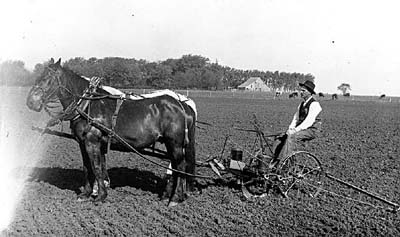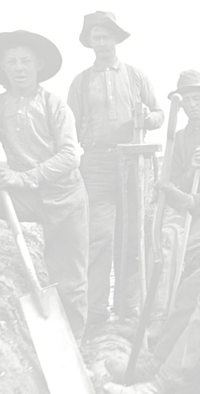Modern Farming Tools: The Seed Planter

The Sadorus' two-horse team pulled a sulky-type feeder. There are two steel runners that dig two rows by moving some soil aside. There are two seed containers, one on each side of the driver's feet. Controlled by the two levers, they drop the seeds onto the ground. Attached and being pulled behind the sulky is a bar with barbs on it for raking over the seeds with a light layer of soil.
Photograph by Frank Sadorus, circa 1910
Illinois State Museum Collection
Gift of Raymond Bial
Early in the twentieth century, traditional seed planters and horse drawn seed planters were still used.
On the Sadorus Farm in 1910, the family used the planter pictured here. After the soil has been plowed and conditioned, it is time to plant seeds.
This planter does not look very different from the planters in the 1830s
- 1850s. There were many variations of planters invented in the nineteenth
century.
· The Buckminster Corn Planter of 1839, pulled by one horse, could
furrow, drop, cover and press down seeds one acre per hour or ten acres per
day, the equivalent of 20 man hours of work.
· The $40.00 Hatch Sowing Machine advertised that it could sow 25 acres
per day behind one horse and man. (It also admitted to having previous defects.)
· The 1846 Pennock Seed and Grain Planter made in Pennsylvania boasted
it could plant 10-12 acres of wheat and 20 acres of corn per day.
· The 1846 Jones and Smith Seed-sowing and Plaster-spreading Machine
had the advantage of being able to adjust to spread lime and guano. It was
priced at $70 for nine feet cylinders.
· In 1850, P. Seymour developed a grain drill that could also deposit
finely-ground manures with the seeds and could be adjusted to be a broadcast
seeder as well. It cost $80 for the nine-tooth version.
Why, in the twentieth century, would the Sadorus farm still use a seeder similar to the ones made fifty years earlier? Many farmers were reluctant to try new machines when the 'old way' of doing things felt comfortable to them ? some models had defects, which caused farmers to distrust them.. Another reason could be that seed planters, along with other farm machinery, sold at prices from $40 to $100, an expensive purchase for a small farmer, who had to have so many machines and tools. It would be economical for a small farmer to continue to use a proven planter, even into the twentieth century.






